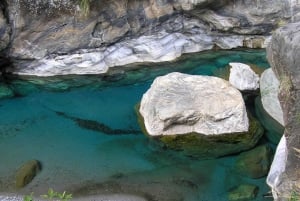Weather Overview
Taiwan Weather
To say that Taiwan is a tropical island is only half true, literally. Thanks to its unique location you will have a chance to experience both subtropical and tropical climate in Taiwan. The northern part of the island including the capital Taipei lies in the Subtropics whereas the southern part is Tropics. To see a handy little map of the climate zones click here.
Taiwan is very humid and the whole island gets very hot between June and September.
Taiwan Climate Zones
To put it in a perspective, Taipei is on the same latitude as Miami, Florida. Taichung would match up with the Key West and from Chiayi further south is where the Tropic of Cancer starts to kick in covering the rest of the island in the tropical climate. The Tropics are characterized by being frost-free year-round and always growing plants.
The north of Taiwan experiences rainy seasons that roughly last from January to March, which is the northeast monsoon, and also the East Asian rainy season (also known as Meiyu meaning plum rain) that comes in May-June.
Unlike the north, the middle and southern parts of Taiwan do not experience an extended rainy season during the winter months.
Temperatures
The annual average temperature on the island is 22C (71.6F).
North annual average temperature: 21.7C (71F)
South annual average temperature: 24.1C (75F)
Generally speaking, the coldest months are January – March with the temperatures ranging from 10 to 17C (50-63F). Keep in mind that the temperatures in the mountains can get much lower as in some cases you can find frost or snow on the high peaks.
The hottest months are June – September bringing the highest temperatures of up to around 38C (100F). Keep in mind that in the big cities like Taipei pollution, traffic etc. can often drive the heat to even higher temperatures.
Please note that due to Taiwan’s high humidity especially the margin temperatures of either end of the spectrum are experienced by many individuals as even hotter or colder. Additionally, nearly all places in Taiwan are equipped with air-conditioning that can often be set to a relatively cold temperature (e.g. 18C/64F). For this reason we advise you to always carry something akin to a sweatshirt with you.
Also, nearly no places in Taiwan are ever heated, nor are they build with insulation, which can result in a much harsher winter experience than it may seem.
Typhoons and Earthquakes
Though the natural disasters in Taiwan have repeatedly proven they can be quite fearsome, most of the time they can be a thrilling even exhilarating experience if you’re well-prepared.
The island experiences earthquakes everyday but you would never notice. Big earthquakes have hit in the past but fortunately, the island hasn’t seen one in a while. Most buildings are also built to withstand the power of the elements and they will purposefully sway precariously to stay upright.
Earthquake Report
2014
|
Taiwan
time
|
Magnitude
|
Depth
(km)
|
Location
|
|
Feb/06 09:40
|
3.7
|
13.6
|
23.82N 121.40E, i.e. 29.1 km SW of Hualien County
|
|
Feb /05 19:17
|
3.5
|
3.4
|
24.69N 121.12E, i.e. 18.5 km SE of Hsinchu County
|
|
Feb /05 19:14
|
3.8
|
2.1
|
24.68N 121.13E, i.e. 20.0 km SE of Hsinchu County
|
|
Feb /04 09:33
|
3.4
|
14.4
|
23.82N 121.45E, i.e. 25.6 km SW of Hualien County
|
|
Feb /02 11:30
|
3.3
|
12.5
|
24.21N 121.08E, i.e. 47.6 km SE of Miaoli County
|
Unlike earthquakes, typhoons are much more common and they hit about 2-3 times per year. When it comes to typhoons your location is extremely important and depending on that you will experience different levels of danger. If you’re in the mountains, you have nothing to fear. On the other, the Eastern side of Taiwan that is facing the ocean can be under a serious threat like during the Typhoon Morakot. Typhoons are mature tropical cyclones that can last for days. They knock over trees, scooters; bring heavy rains and over-all make for a very unpleasant experience.
During serious typhoons schools, government buildings, and almost all of Taiwan, will close down. To see typhoon warnings from Taiwan’s Central Weather Bureau click here.
 26 °C
26 °C
 light rain
light rain broken clouds
broken clouds broken clouds
broken clouds broken clouds
broken clouds moderate rain
moderate rain heavy intensity rain
heavy intensity rain light rain
light rain light rain
light rain light rain
light rain overcast clouds
overcast clouds light rain
light rain broken clouds
broken clouds light rain
light rain overcast clouds
overcast clouds broken clouds
broken clouds overcast clouds
overcast clouds broken clouds
broken clouds scattered clouds
scattered clouds scattered clouds
scattered clouds broken clouds
broken clouds broken clouds
broken clouds broken clouds
broken clouds light rain
light rain overcast clouds
overcast clouds light rain
light rain light rain
light rain light rain
light rain light rain
light rain light rain
light rain light rain
light rain light rain
light rain light rain
light rain light rain
light rain light rain
light rain












